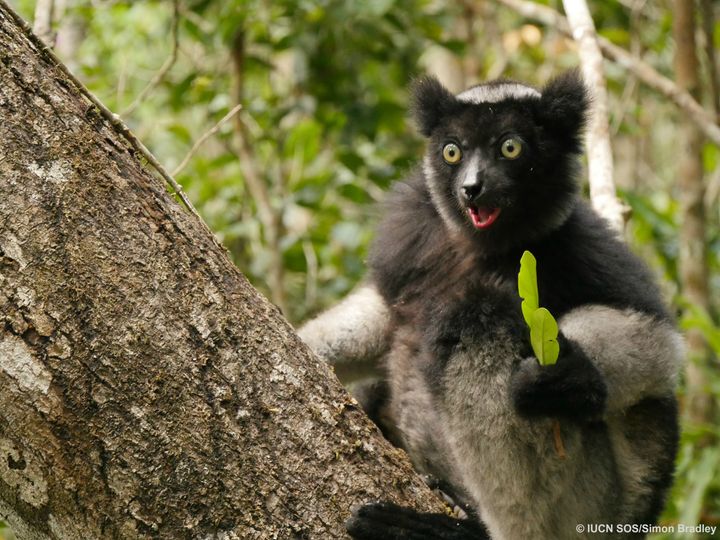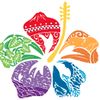
Critically Endangered Indri
Lemurs are synonymous with Madagascar – all 111 species only occur on this France-sized island. One legend says that the Malagasy people are descended from the Babakoto: a local name for the iconic and Critically Endangered Indri (Indri indri), the largest of the surviving lemur species. Lemurs also represent one of the island’s most valuable assets for eco-tourism. The fates of lemurs are truly intertwined with those of the Malagasy people and only by working with local communities can these unique primates be saved from extinction – writes IUCN’s Jean-Christophe Vié.
People and lemurs in Madagascar face overlapping challenges. Widespread poverty means people look to the forests and other natural spaces for fuel, food and minerals and often exploit these resources unsustainably, leading to the destruction of lemur habitats. Meanwhile, almost 90% of the 103 lemur species so far assessed for IUCN Red List of Threatened Species are threatened with imminent extinction.
Many of these challenges can be addressed through relatively straightforward solutions that involve a shift from conflict to coexistence with nature. By supporting civil society organisations in their work with communities to protect lemurs, IUCN’s grant-making initiative SOS – Save Our Species drives this process from the grassroots up, guided by a strategy developed by the world’s lemur experts.
Solutions include empowering communities to protect their natural heritage, connecting habitats through reforestation or using fuel-efficient cooking methods. By involving all generations in the conservation process, whether through employment – such as in patrolling protected areas, managing them or offering eco-tourism related services – or through education and outreach, we can align the future of lemurs and of Madagascar’s booming youthful population, 60% of whom are under 25 years of age.
This can be done through a variety of methods. For example in Kianjavato, several hours’ drive south of the capital Antananarivo, a community tree planting programme earns villagers ‘conservation credits’ that can be exchanged for useful products like fuel-efficient stoves, bicycles, sewing machines and solar panels. The programme has so far led to local people planting 1 million trees over the last 5 years, generating improved quality of life for local community members in return.
Near Lac Alaotra, ten hours’ drive to the north of Antananarivo and an important rice basket and freshwater fishery, communities are pilot-testing drought-resistant rice that can be grown on marginal lands away from the lake. This offers an alternative to clearing the few remaining marshlands which represent the last remaining habitat of the Critically Endangered Alaotra reed lemur (Hapalemur alaotrensis), found only in the papyrus reeds around this lake. The Madagascar pochard, a type of bird, once thought extinct and recently rediscovered elsewhere in Madagascar, may also come back as a result of this project.
Another project is using competition to encourage youth groups to promote awareness about lemur conservation in return for training in improved agricultural methods. The winning teams will travel to the World Lemur Festival main event in Antananarivo in October 2017. Open to anyone anywhere in the world, its success to date highlights the power and efficiency of tapping into a celebratory spirit to engage people in the conservation message. We look forward to participating in this year’s festivities during October 2017.
Lemur conservation also allows eco-tourism based around primate-watching to thrive. Nowhere in the world can one expect to see so many species of primates so easily. Indeed, Madagascar’s primate diversity rivals that of Brazil – a country 14 times larger. The tourism industry directly contributes almost 6% of Madagascar’s gross domestic product (GDP). It could contribute significantly more if managed sustainably.
Of course, the SOS approach is not a silver-bullet: such is the scale of the challenge. While forests still cover about 22% of the island, just 5% of the total land area is protected. Meanwhile, national infrastructure is either undeveloped or creaking with wear and tear. In the rainy season, some areas are simply inaccessible. Access to education and telecommunications is not yet universal.
Indeed poverty is the norm and the risk of institutional corruption remains high. Trading in threatened wildlife products such as Ploughshare tortoises and Rosewood timber can generate cash returns far greater than average annual earnings. Similarly the prospect of getting rich quick through artisanal gem mining is environmentally problematic. A rush to dig for sapphires in late 2016 frayed the delicate edges of the rainforests of Didy in eastern Madagascar, threatening more of its fragile biodiversity.
It is apparent that for Madagascar to save lemurs, there is a mosaic of issues to address. These few anecdotes indicate that win-win solutions for Malagasy people and wildlife are possible when investments are made in a future that benefits both. The fact that many of these activities have been generated by Malagasy minds is the truly inspiring detail we will highlight for years to come. Championing their own unique natural heritage – we echo their call to save our species and save ourselves.
